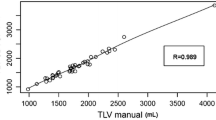Abstract
The authors have developed a system to measure the volume of the liver parenchyma and tumors using computed tomographic images printed on film. The present study was carried out to clarify the usefulness of this method to assess both liver volume and the relationship between the volume increase and the functional recovery. We investigated 55 patients who underwent a hepatic resection of more than one segment. We calculated the effective resection ratio and the liver volume increase at the 4th postoperative week to evaluate postoperative hepatic insufficiency. The liver volume increase 4 weeks after surgery correlated significantly with the effective resection ratio and also showed an inverse correlation with the severity of chronic changes in the liver. The liver volume increase also inversely correlated with the preoperative retention of indocyanine green at 15 min. Patients with postoperative hepatic insufficiency tended to show a smaller liver volume increase than expected for their resection ratio. In contrast, noncirrhotic patients had no such particular tendency. In conclusion, measurement of the liver volume using this technique appears to be a simple and useful method to evaluate liver volume after resection; as such, it may also be used to evaluate hepatic regeneration after resection.
Similar content being viewed by others
References
Yamanaka N, Okamoto E, Kawamura E, Kato T, Oriyama T, Fujimoto J, Furukawa K, Tanaka T, Tomoda F, Tanaka W (1993) Dynamics of normal and injured human liver regeneration after hepatectomy assessed on the basis of computed tomography and liver function. Hepatology 18:79–85
Halpern A, Bircher J, Tauber J, Blankart R, Rosler H, Preisig R (1971) Specific liver function: liver volume as reference parameter of the function (in German). Schweiz Med Wochenschr 101:736–737
Liver Cancer Study Group of Japan (1987) The general rules for the clinical and pathological study of primary liver cancer, 2nd edn. (in Japanese). Kanahara Shuppan, Tokyo, pp 21–22
Une Y, Ogasawara K, Kamiyama T, Misawa K, Matsuoka S, Nakajima Y, Uchino J (1993) A simple method for estimation of liver volume using CT-scan after major hepatic resection (in Japanese with English abstract). Nippon Geka Gakkai Zassi (J Jpn Surg Soc) 94:702–706
Okamoto E, Kyo A, Yamanaka N, Tanaka N, Kuwata K (1984) Prediction of the safe limits of hepatectomy by combined volumetric and functional measurements in patients with impaired hepatic function. Surgery 95:586–592
Dorph S, Oigaard A (1973) Variations in renal size in the diagnosis of renovascular hypertension. Br J Radiol 46:187–190
Rasmussen SN, Kardel T, Jorgensen BJ (1975) Liver volume estimated by ultrasonic scanning before and after portal decompression surgery. Scand J Gastroenterol 10:25–28
Gazzard BG, Portmann B, Murray-Lyon IM, Williams R (1975) Causes of death in fulminant hepatic failure and relationship to quantitative histological assessment of parenchymal damage. Q J Med 44:615–626
Yokoyama M, Watanabe K, Inatsuki S, Ochi K, Takeuchi M (1982) Measurement of renal parenchymal volume using computed tomography. J Comput Assist Tomogr 6:975–977
Lerman LO, Bentley MD, Bell MR, Rumberger JA, Romero JC (1990) Quantitation of the in vivo kidney volume with cine computed tomography. Invest Radiol 25:1206–1211
Mizumoto R, Kawarada Y, Noguchi T (1979) Preoperative estimation of operative risk in liver surgery with special reference to functional reserve of the remnant liver following major hepatic resection. Jpn J Surg 9:343–349
Rollo FD, De Land FH (1968) The determination of liver mass form radionuclide imaging. Radiology 91:1191–1194
Walk L (1961) Roentgenologic determination for the liver volume. Acta Radiol 55:49–56
Carr D, Duncan JG (1976) Liver volume determination by ultrasound: A feasibility study. Brit J Radiol 49:776–780
Heymusfield SB, Fulenwider T, Nordlinger B, Barlow R, Sones P, Kutner M (1979) Accurate measurement of liver, kidney, and spleen volume and mass by computerized axial tomography. Ann Intern Med 90:185–187
Imamura M, Tobe T, Hayashida T, Takagi T, Yamamoto S (1978) Estimation of the volume of the liver with CT scan (in Japanese). Igaku No Ayumi (J Clin Exp Med) 120:747–750
Kan MK, Hopkins GB (1979) Measurement of liver volume by emission computed tomography. J Nucl Med 20:514–520
Asano K, Ozawa K, Tobe T (1983) Postoperative prognosis as related to blood ketone body ratios in hepatectomized patients. Eur Surg Res 15:302–311
Higgins GM, Anderson RM (1931) Experimental pathology of the liver. Arch Pathol 12:186–202
McDermott WV Jr (1970) Circulatory changes associated with major hepatic resection. Ann NY Acad Sci 170:246–250
Laurent TC, Fraser JR (1992) Hyaluronan. FASEB J 6:2397–2404
Kodama M, Tani T, Inoue N (1993) Therapeutic plasmapheresis to treat postoperative hepatic failure clinical course and therapeutic outcome in Japan (in Japanese). Nippon Geka Gakkai Zasshi (J Jpn Surg Soc) 94:707–713
Rousset A, Huault G (1993) Pre- and postoperative intensive care after liver transplantation (in French). Pediatrie Bucur 48:145–149
Ravinobici N, Wiener E (1961) Liver regeneration after partial hepatectomy in carbon tetrachloride-induced cirrhosis in the rate. Gastroenterology 40:416–422
Nagase N, Yukata H, Ogawa Y, Kohno H, Nakamura T (1986) Human liver regeneration after major hepatic surgery. Ann Surg 206:30–39
Okamoto E, Yamanaka N (1983) A morphometric study on regeneration of the human liver following hepatectomy by computed tomography (in Japanese with English abstract). Kanzo (Acta Hepatol Jpn) 49:870–877
Une Y, Ogasawara K, Koike M, Namieno T, Nagabuchi E, Uchino J (1991) Experimental study on the effect of vagotomy on hepatic regeneration after resection (in Japanese with English abstract). Kanzo (Acta Hepatol Jpn) 32:837–842
Author information
Authors and Affiliations
Rights and permissions
About this article
Cite this article
Ogasawara, K., Une, Y., Nakajima, Y. et al. The significance of measuring liver volume using computed tomographic images before and after hepatectomy. Surg Today 25, 43–48 (1995). https://doi.org/10.1007/BF00309384
Received:
Accepted:
Issue Date:
DOI: https://doi.org/10.1007/BF00309384




